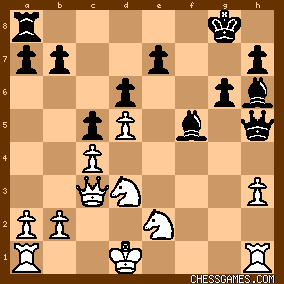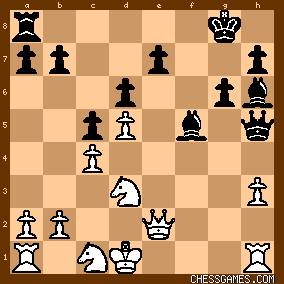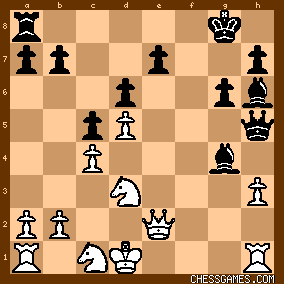|
< Earlier Kibitzing · PAGE 3 OF 4 ·
Later Kibitzing> |
| Mar-05-15 | | maseras: Sep-09-13 DrGridlock: <crazyedmen: what's wrong with 16 Nxf3?>
Indeed!
Nunn's own annotations (from "The World's Greatest Chess Games") are: "Or 16 Nxf3 Nxf3+, 17 Kd1 Bf5, 18 Bg3 Qe3, 19 Bf2 Qxe4, 20 Qxe4 Bxe4, 21 Bg2 Rf8 and Black already has one pawn for the exchange while the clumsy white rooks will be no match for his energetic bishops." Komodo finds:
click for larger view
Analysis by Komodo32 3 32bit(depth=22):
1. ² (0.66): 16.Nxf3 Nxf3+ 17.Kd1 Bf5 18.Bg3 Qe3 19.Qd3 Qxe4 20.Qxe4 Bxe4 21.Bg2 Rf8 22.a4 Nd2 23.Bxe4 Nxe4 24.Ra3 Bf4 25.Bxf4 Nf2+ 26.Ke2 Nxh1 27.Rf3 gxh5 28.Bg5 Rf7 29.Rxf7 Kxf7 30.Kf3 e6 31.Kg2 exd5 Where White has an advantage after all.
This game is filled with positions like this where the correct defensive resource (16 Nxf3 or 20 Qc3) just doesn't "look" right, but actually plays right. You are right.After 20...Rf8,Black just have companse but thats all. |
|
| Nov-05-16 | | diagonalley: didn't even look at 20.... N-Q7 - <diagonalley> nul points :-( |
|
| Nov-05-16 | | sfm: Got it immediately - but hmmm, maybe it helped that I played through the game two days ago, when I was looking for the worst pun of all times, and, so, found it.
I have secretly made an arrangement with Morphishine to finance a hired killer for anyone who in the future muses over the phonetic similarity between 'Nunn' and 'none'. The game is absolutely fabulous. |
|
| Nov-05-16 | | YouRang: Saturday 20...?

click for larger view
Well, I wanted to make ...Qe1+ work, but no. Then I considered 20...Qxh5, but 21.Qe2 pins my knight. After a few other tries that were too complicated to be confident of, I decided settled on the simpler <20...Nd4>

click for larger view
This gets my knight out of attack range, attacks white's queen, and prevents white from defending Ph5 via Qe2 since the N also attacks e2. Black now controls all the squares around white's king, which has to be good. Black threatens ...Qxh5+ with strong attack. For example, maybe <21.Qc3 Qxh5+ 22.Be2 Nxe2 23.Nxe2>

click for larger view
Black can scoop up a piece with <23...Qf3> attacking Rh1 and double-attacking Nd3. Still, it's pretty complicated. I don't doubt that I'm missing something. |
|
| Nov-05-16 | | AlicesKnight: Nowhere near :-( A fascinating complex where the Black N runs rings around the entire White team. |
|
| Nov-05-16 | | gofer: Well, <20 ... Nd2!> is obvious. It screams to be played... ...errr, perhaps that's not completely true...
I didn't even consider <20 ... Nd2!> as a solution. I looked at Ne1+, Ng1 and Nd4, but for some reason totally overlooked Dr Nunn's choice. Probably because I am not Dr Nunn. I, like <YouRang>, went for the more obvious choice... <20 ...Nd4>
21 Qc3 Be4
22 Rh2 Rf8 
21 Qg2 Be4
22 Qf2 Qxh5+ 
<21 Qf2 Qxh5+>
<22 Be2 Qg5>
<23 Bf1 Rf8>

click for larger viewThe abyss between between my thoughts and the line played is so vast and so deep... <Nul Points!> |
|
| Nov-05-16 | | morfishine: Famous Game |
|
| Nov-05-16 | | thegoodanarchist: Beliavsky went "belly up-ski" |
|
| Nov-05-16 | | RandomVisitor: 
click for larger viewKomodo-10.1-64bit:
-6.87/39 20...Nd2 21.Qc3 Nxc4 22.Nf4 Nxb2+ 23.Qxb2 Qxf4 24.Nb3 Qf3+ 25.Qe2 Qxh1 26.Qg2 Qxg2 27.Bxg2 Rf8 28.Bf1 Be4 29.Ke1 gxh5 30.Rd1 Bc2 31.Ra1 Rf5 32.Be2 Be4 33.Nd2 Bxd5 34.Rc1 Rg5 35.Rc2 Rg1+ 36.Nf1 Kg7 37.Rc3 Bg5 38.a4 e6 39.Kf2 Bf6 40.Kxg1 Bxc3 41.Kf2 Bd4+ 42.Ke1 Bc6 43.Bd1 Bg2 44.Bxh5 c4 45.Bg4 Kf6 46.Ke2 h5 47.Bxh5 c3 -4.90/39 20...Rf8 21.Be2 Nd2 22.Qc3 Nxc4 23.Nf4 Nb6 24.Ncd3 Bxd3 25.Bxd3 Rxf4 26.hxg6 hxg6 27.Rg1 Rd4 28.Rxg6+ Bg7 29.Kc2 Nxd5 30.Qe1 Nb4+ 31.Kb3 Nxd3 32.Qxh4 c4+ 33.Ka3 Rxh4 34.Rag1 Rh7 35.b3 Kf7 36.bxc4 Bd4 37.R1g5 Ne5 38.Rg8 Rxh3+ 39.Rg3 Rh2 40.Rg2 Rxg2 41.Rxg2 Nxc4+ 42.Kb3 d5 43.Rh2 e5 44.Rh7+ Ke6 45.Kc2 b5 46.Kd3 Kd6 47.Rh8 a5 48.Rd8+ Ke6 49.Rc8 b4 50.Re8+ Kd7 51.Rg8 Kd6 |
|
| Nov-05-16 | | RKnight: I considered maneuvering the knight to e6, but didn't see how. Nd2 didn't even enter my mind. Nunn-the-less, I think I may have found an alternative winning line: 21...Nd5, 22. Qf2 Qxh5+, 23. Be2 Nxe2 (diverging from <gofer> above), 24. Nxe2 (if 24. Qxe2, Bg4), Bxd3 followed by 25... Rf8 which seems crushing. Maybe one of the engines can find a hole in the above. |
|
Nov-05-16
 | | saffuna: Funny how Beliavsky finally gets his queen over to the kingside to help on move 23, only to see Nunn switch the action to the queenside two moves later. |
|
| Nov-05-16 | | gofer: <RKnight>: I don't think you have found quite the improvement you were hoping for... <21 ... Nd4>
<22 Qf2 Qxh5+>
<23 Be2 Nxe2>
After 23 ... Nxe2, white has to play 24 Qxe2 (not Nxe2) to avoid 24 ... Bxd3 winning a knight. So instead white plays <24 Qxe2>
and we reach here...

click for larger view...at which point you propose
<24 ... Bg4??>

click for larger view<25 Qxg4  > >
Black is down R+N for 2 pawns and is about to trade off queens into a lost end game... |
|
| Nov-05-16 | | patzer2: Fascinating Saturday problem (20...?) today. Black is a Rook down, but as compensation he has an extra pawn and active, well developed pieces with excellent attacking prospects. Meanwhile White's position is a complete wreck. Like pieces of driftwood randomly washed up on the shore, White's pieces are stuck on the first and second rank in awkward, uncoordinated positions. In the midst of all this dead wood, the White King is stuck in the middle of the board, unable to castle. Even though the White side pieces have superior numbers, their lack of coordination leaves them defenseless against the incisive attack of Black's active, well developed pieces. After seeing his surprising problem-like tactical solution 20...Nd2!  , I thought to myself it's little wonder GM John Nunn went on to become a three-time winner of the World Chess Solving Champion in 2004, 2007 and 2010. , I thought to myself it's little wonder GM John Nunn went on to become a three-time winner of the World Chess Solving Champion in 2004, 2007 and 2010. Unfortunately, I didn't see John Nunn's strong and best solution. Instead I went for 20...Nd4  , which, though weaker than Nunn's 20...Nd2!, appears to win with difficulty. , which, though weaker than Nunn's 20...Nd2!, appears to win with difficulty. My long move-by-move look with Deep Fritz 15 indicates Black wins with 20...Nd4 after 21. Qf2 [] Qxh5+ 22. Be2 [] Qg5 23. Qe1 [23. Qf4 Qg2 24. Qh2 Qe4 25. Re1 Nxe2 26. Rxe2 Qxc4 27. Qg3 Rf8 28. Nf2 Qxd5+ 29. Ke1 e5 30. Ncd3 c4 31. Nb4 Qc5 32. a3 a5 33. Na2 Bd3 34. Nc3 Bf4 35. Qg4 Bxe2 36. Nxe2 Bh6 37. Qg3 d5 38. Rd1 d4 39. Ng4 Bg7 40. Qg2 d3 41. Qxb7 h5 42. b4 axb4 43. axb4 Qd6 44. Qb5 Qe6 45. Ne3 dxe2 46. Kxe2 Qxh3 47. Qxc4+ Kh7 48. Qd5 Qh4  (-4.15 @ 21 depth, Deep Fritz 15)] (-4.15 @ 21 depth, Deep Fritz 15)] 23... b5 24. Rg1 [] Qf6 25. Qc3 [] b4 26. Qe1 [] e5 27. Rf1 [] Rf8 28. Nb3 Nxe2 29. Qxe2 Bxd3 30. Rxf6 Bxe2+ 31. Kxe2 Rxf6 32. a3 bxa3 33. Rxa3 e4 34. Rxa7 Rf3 35. Nd2 Rxh3 36. Ra8+ Kf7 37. Ra7+ Kf8 38. Rxh7 Rh2+ 39. Kf1 e3 40. Ne4 e2+ 41. Ke1 Bd2+ 42. Kxd2 Rxh7  (-3.85 @ 27 depth, Deep Fritz 15). (-3.85 @ 27 depth, Deep Fritz 15). The winning follow-up after 20...Nd2! is pretty straight forward. However, a couple of alternatives to White's 21. hxg6 require a bit of calculation: If White plays 21. b3, Black wins after 21...Qe4 22. Rg1 Qe3 23. Rh1 (23. Rg2 Qf3+ 24. Be2 Qxg2) 23... Qf3+ 24. Ke1 Qxh1  (-20.61 @ 20 depth, Deep Fritz 15). (-20.61 @ 20 depth, Deep Fritz 15). If White plays 21. Qc3, Black wins after 21...Nxc4 22. Nf4 Nxb2+ 23. Qxb2 Qxf4 24. Rg1 Bg7 25. Qd2 Qxd2+ 26. Kxd2 Bxa1  (-3.61 @ 20 depth, Deep Fritz 15). (-3.61 @ 20 depth, Deep Fritz 15). |
|
Nov-05-16
 | | offramp: This game took place on the 19th January 1985. The next day in England the Queen declared an amnesty, all prisoners were allowed free; fireworks were detonated at the Tower of London; a man appeared on the BBC saying that services had been suspended. People jumped into the Thames and they all died. I remember every second of it, including the appearance of UFOs over Buckingham Palace. |
|
| Nov-05-16 | | Howard: Seirawan once referred to this game as the best one of the 80's. Rather exaggerated, in my view. |
|
| Nov-05-16 | | patzer2: Perhaps White might have improved his chances by replacing 9. h3 = (-0.25 @ 29 depth, Stockfish 7) with the more active 9. Bg5 = (0.05 @ 28 depth, Houdini 4 x 64) as in White's wins in Kramnik vs Z Lanka, 1992,
Karpov vs Nunn, 1993 and A Volodin vs I Saric, 2010. Earlier in the opening, instead of 5. f3 = (0.23 @ 38 depth, Stockfish 7) , it would appear the computer programs and most GMs now prefer 5. Nf3 = to  (0.38 @ 41 depth, Komodo 9.3) as in White's wins in W So vs F Perez Ponsa, 2016,
J Xiong vs K Yang, 2016 and
M Ragger vs S Maze, 2016. (0.38 @ 41 depth, Komodo 9.3) as in White's wins in W So vs F Perez Ponsa, 2016,
J Xiong vs K Yang, 2016 and
M Ragger vs S Maze, 2016. |
|
| Nov-05-16 | | agb2002: I haven't found the time today for this interesting puzzle. |
|
| Nov-05-16 | | patzer2: As <Dr. Gridlock> observes in a post from Sep, 2013, 16. Nxf3 Nxf3+ 17. Kd1 Bf5 = would have given White good survival chances. However, Black missed a chance two moves earlier by not playing 14...Qf5!  to to  (-1.63 @ 21 depth, Deep Fritz 15). (-1.63 @ 21 depth, Deep Fritz 15). |
|
| Nov-05-16 | | mel gibson: Too hard for me.
DR4 64 bit sees it if you only allow it
8 plies or 8 half moves.
It does that in much less than 1 second.
Computers have changed everything.
By the way -
the computer comes up with such a different variant after that move even
when you give it only 6 seconds per move to think. That means the game above is technically not perfect. |
|
Nov-05-16
 | | Willber G: I went with:
20...Bg4 threatening to win the Q with 21...Nd4+ but 21.Qc2 seems to defuse it. But Nd4+ here still looks like an interesting position for black although I couldn't find a win. |
|
| Jul-09-18 | | dehanne: It's coming home. |
|
Jan-31-20
 | | Plaskett: It´s a highly creative game.
The novelty and the consequent rook sacrifice I know to have been produced, almost certainly, without computer aid.
But, for all that, Nunn´s annotations in "The World´s Greatest Chess Games" are not objective:
"Or 16 Nxf3 Nxf3+, 17 Kd1 Bf5, 18 Bg3 Qe3, 19 Bf2 Qxe4, 20 Qxe4 Bxe4, 21 Bg2 Rf8 and Black already has one pawn for the exchange while the clumsy white rooks will be no match for his energetic bishops."
That is simply wrong for the queen´s rook enters the game after 22 a2-a4! So Beliavsky could thus have refuted the sacrifice.
Apparently he thought for some time over his excellent move 14 Ne4!.
Nunn had not considered it all that seriously in his preparations. |
|
Feb-01-20
 | | MissScarlett: <But, for all that, Nunn´s annotations in "The World´s Greatest Chess Games" are not objective: "Or 16 Nxf3 Nxf3+, 17 Kd1 Bf5, 18 Bg3 Qe3, 19 Bf2 Qxe4, 20 Qxe4 Bxe4, 21 Bg2 Rf8 and Black already has one pawn for the exchange while the clumsy white rooks will be no match for his energetic bishops." That is simply wrong for the queen´s rook enters the game after 22 a2-a4!> But Black is much better then after 22...Nd4. The problem with Nunn's line, as indicated in previous analysis, is that 19.Bf2 is a serious error, leaving it vulnerable to the eventual ...Rf8. Instead 19.Qd3 forces the exchange on e4 and the Bishop remains on g3. To that extent, 18...Qe3 is preferable to the immediate 18...Qxe4, because it invites the potential error. |
|
| Jul-26-20 | | Chesgambit: Classical game |
|
| Jul-26-20 | | Chesgambit: 20...Nd2 of course best |
|
 |
 |
|
< Earlier Kibitzing · PAGE 3 OF 4 ·
Later Kibitzing> |
|
|
|





